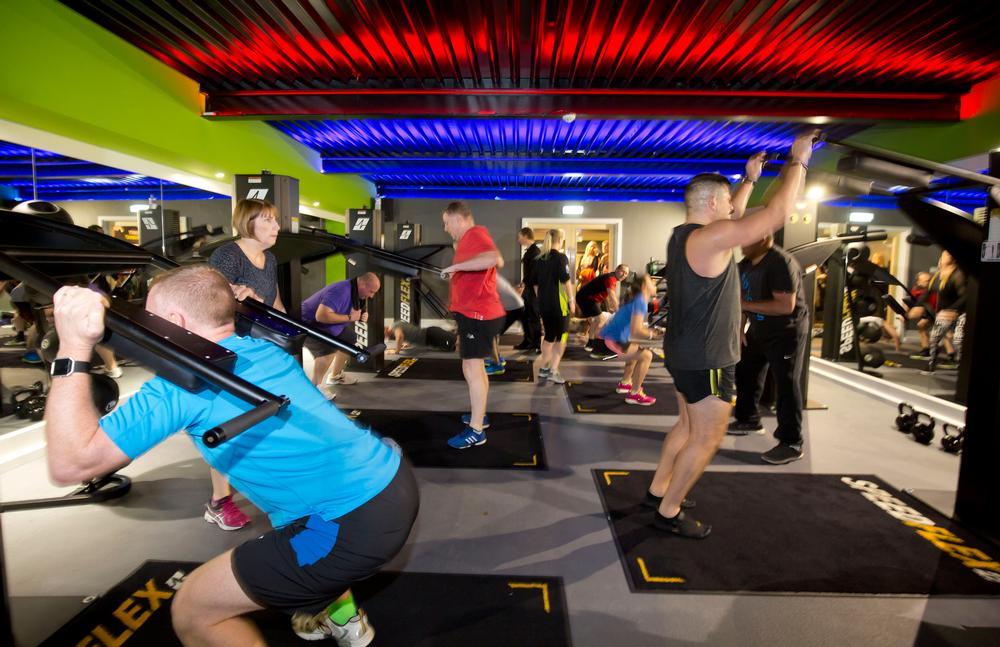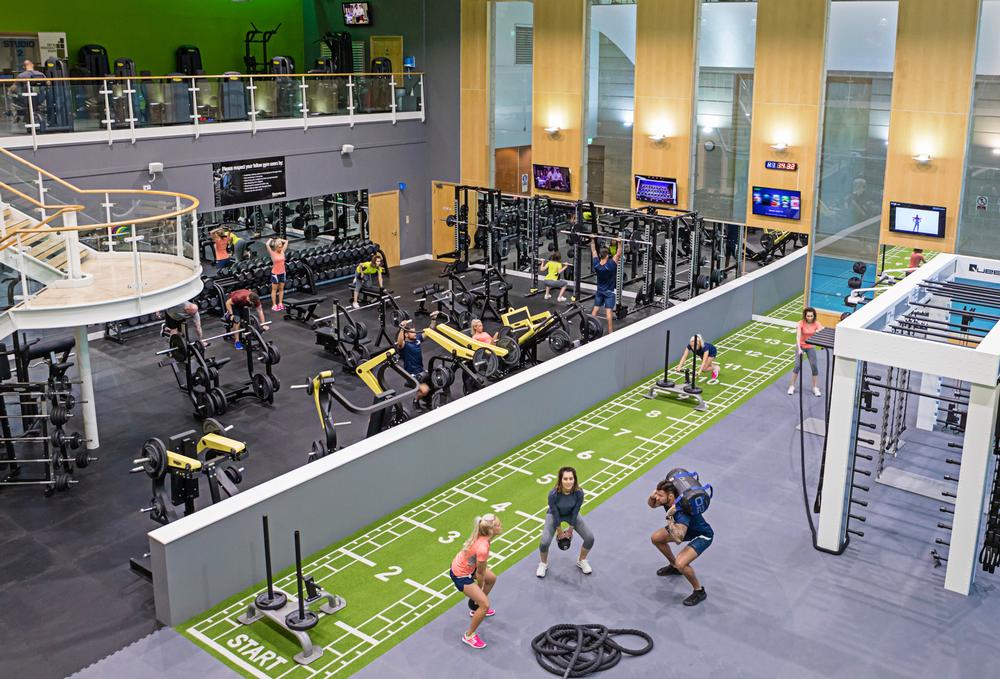We have a leadership team of ‘non-health club origin’, which means we have a very different take on where the industry should be going,” says Justin Musgrove, CEO of The Bannatyne Group.
“Over recent years, we’ve all seen the market polarise. Our business faced the same question at the end of 2014: do we go up or down? For me there was only one answer: we had to go upmarket. But – and this is what makes our approach different – we did so at mid-market prices, charging on average £45 a month for membership. This is ultimately the secret of our success over the last few years.”
Spa as a USP
Key to the shift upmarket has been a growing emphasis on spa – an area in which Musgrove has a wealth of expertise. Having joined Center Parcs in the late 80s, working in leisure and specialising in swimming pools, he switched his focus to spa 18 years ago.
He explains: “At the time, the Center Parcs spas were being developed under the Aqua Sana brand and I was on the operational leadership team, bringing those locations to life.
When the company floated, I was given the task of taking Aqua Sana to the high street. We were looking at locations in the UK and overseas, but things changed when Blackstone acquired Center Parcs, that plan was dropped and it was time for me to move on to pastures new.
“In 2007, I joined The Bannatyne Group to drive its newly acquired spa business; Bannatyne had just acquired LivingWell from Hilton. At the time, the spa business had reasonable turnover but little profit. We saw this as an opportunity: my job was to drive that business and make it profitable.”
And the opportunity was duly realised, as Musgrove explains: “Our spas are now a £20m business and growing rapidly. One factor driving that has been our online booking system,” says Musgrove, “Over 80 per cent of transactions are now done online, with total spa bookings up by around 25 per cent year-on-year.”
Interestingly, 92 per cent of Bannatyne’s spa business comes from non-members visiting on day spa packages. Of these, around 70 per cent book direct, with the rest coming through third-party and gift card resellers such as Red Letter Days.
Spa guests, whether members or non-members, have access to spa areas that typically comprise between six and 12 treatment rooms, a dedicated manicure-pedicure area and a luxurious relaxation room. They also have access to the rest of the health club, including the gym, classes, all heat treatment areas, such as saunas and steamrooms and the café.
For those accustomed to the likes of Champney’s and Center Parcs, the offering may not appear extensive, but as Musgrove explains: “We’re a health club at the end of the day and our prices reflect that: non-members pay from £79 for a spa day for two people. For that, they can do a workout, perhaps try a pilates or yoga class, have a swim, treat themselves to some lunch in the club’s café, then come in and have a wonderful Elemis spa treatment followed by some downtime in our relaxation room.
“Some guests comment that they had a spa day, but it was in a health club environment, but that’s OK, because that’s exactly what we aim to do. We’re a health club and this is our USP.
It’s a different angle on spa, but it’s proven to be very successful for us.”
And the environment certainly isn’t holding the business back from venturing into specialist areas such as Wellness for Cancer, as Musgrove explains: “In years gone by, we’ve had to turn people with cancer away. The advice from insurers was that we shouldn’t take the risk.
“With all the new medical evidence coming out, I now believe this was bad advice. We’re using a specialist provider to train as many of our people as possible in providing treatments for those either undergoing cancer therapy or in remission. There are so many people these days with cancer…. It isn’t just about a commercial opportunity – it’s also very much the right thing to do.”
Returning to the original thread of conversation, Musgrove continues: “Of course, the fact that 92 per cent of our spa business comes from non-members represents a significant opportunity to grow the proportion of Bannatyne health club members who use our spas.
“Since 2007, we’ve grown our number of spas from 24 to 46 – we have them in two-thirds of our clubs – and it’s a great USP. Yet at the moment, only 8 per cent of our business comes from members, in spite of the preferential rates.
“So we’ve launched a new wellness bundle. For £30 a month, members can choose either a one-hour or two 30-minute Elemis spa treatments each month – actual value £60. It will mean a bit of reduced income, but the big prize is that members will hopefully stay with us.”
Going premium
But spa hasn’t been the only area of focus in taking the Bannatyne offering upmarket: £27m has been invested in the gyms over the last two years – in part thanks to a new strategy involving Bannatyne’s partnership with Technogym.
Musgrove explains: “Since 2000, gyms have routinely had new equipment every four years, but now we’re reviewing assets more intelligently, keeping some products longer but also being responsive in updating key areas more regularly to continually innovate and reflect members’ interests.
“We’ve found members appreciate this more nimble approach of focusing investment where it makes a difference.
Most importantly, this has allowed us to put some of the CapEx into the infrastructure of the gym space: new lighting, flooring, décor and generally a refreshed space to work in.
Where previously we went 15 years between refurbs, by which time things looked dated, we’ll now be able to have a major gym floor refit every seven years.
“And the real beauty is that, with a third of our gym floor now dedicated to functional training, we have very versatile space at our disposal. If there’s a trend for, let’s say, trampolining or pole dancing, we have a flexible model that allows for this space to be swapped out at relatively low cost. That keeps us current.”
Also keeping the offering current are a number of other fitness innovations. These include Speedflex studios, which have been launched at 10 locations since January 2017. “In our Darlington club – which is where we do our experimenting, as it’s right next to HQ – we run three or four Speedflex classes a day and they’re included in the membership,” says Musgrove. “Occupancy is in the high 90 per cents and we’re getting fabulous feedback and great repeat usage.”
Hatton boxing partnership
“We also introduced group training in partnership with Hatton Boxing this month,” he says. It’s a 10-week programme for a maximum of 12 people, priced at £250 per person. This includes 10 one-hour training sessions, InBody assessments and also £190-worth of Hatton merchandise: boxing gloves, pads, T-shirt and hoodie. They train together and it’s all about getting results.”
Musgrove continues: “It isn’t just about the gym floor though. We’re also looking at everything else in the club, from the changing rooms to the layouts and from the systems to the brands we partner with.
“For example, we’ve improved our café, partnering with Starbucks and making sure the food is healthy and convenient – freshly baked jacket potatoes and so on.
“These aren’t headline-grabbers, but they’re core improvements. We’re looking to innovate across the whole business and get every single part of it ship-shape over the next two years.
“That’s really important because we’ve already seen how high street retailers are losing out to online operators. If we’re not careful, this will start impacting fitness as well, with people doing things at home rather than in the gym. We don’t see this as a major threat but we can’t be complacent, so our key focus for the next two years is on creating an experience culture. How do we make the experience at the club a social one – something members can’t afford to be without?
“We recognise there’s a need to help members stay active while they’re away from the club, so we’re working on an app whereby they have a virtual personal trainer on their phone and can train at home. We know if they get results and we’ve helped them do that, they’re more likely to stay with us.
“But for us, the key to success in this competitive landscape is making sure people attend regularly. Health clubs used to make money off the back of people not turning up, but we want to encourage people to come, not only because attendance drives ‘stickiness’ – the bond people feel to our clubs – but also because we get the secondary spend – the spa treatments, coffee sales and so on.
“In turn, this secondary spend gives us great data to understand members, because people are paying cashlessly using their Bannatyne 360 wristband. This is used both for access and payment, so we have a whole new level of intelligence around member behaviour and can refine our offering accordingly.”
Staff as ambassadors
Significant investment is also going into staff training, as Musgrove explains: “I believe we have a responsibility to improve the basic standards of fitness staff. We have Lifetime Training working with us and we’ve just recruited two of our best fitness managers to be on the road, dedicated to training and providing good programming for our teams.
“We want to make sure staff are fit too. That might sound daft, but there are so many fitness advisors who don’t practise what they preach. We want to make sure we have ambassadors on the gym floor – people who live and breathe fitness and who will give the right education to our members.”
He continues: “In terms of the member journey, we’re shifting our efforts from the back end – reactive interventions when a member says they want to leave – to the front end, making sure people get a great induction and a lot of contact with us in the first 12 weeks. That’s already paying dividends.
“We’re also focusing on customer experience training, learning how to build experiences and relationships and how to empower people. This is being applied across the board – everyone in the club can add to the member experience – I believe some of the most important people in a health club are members of the cleaning team. They’re often the ones who talk to members every day.
“But the thing I’ve really learned is that staff need to understand what’s in it for them. Why should they interact with members and make them feel special? And the answer is this: if you’re looking for a career, the people who progress are those who make the effort to give great service and great experiences. They get talked about by the member, they get referred, they get great mystery shop audits, so they’re the people we invest in and fast-track through our programmes.”
The obvious area we haven’t yet touched on is hotels – a division of the company previously identified as a growth area for Bannatyne.
“When we bought hotels in the past, we generally got very good deals and were either able to add an integrated health club and spa, or the hotel was close to one of our clubs,” says Musgrove. “The synergies are clear between the three areas of our business and all our hotels are profitable.
“However, we’re not looking to ramp up this area. Hotels are challenging, especially when you only have four, as we do. They take disproportionate effort compared to running gyms and spas.
“For example, the size of our health club estate means clubs aren’t too far apart, so if we lose a GM, it’s easy to support that club. Our hotels, by contrast, are very spread out and it’s difficult to attract the right employees.
“We have two choices: either we scale up and get to 10 or 20 hotels, or we stay where we are. For now, our strategy is the latter. We have no plans in the short term to dispose of our hotels, but equally, we don’t intend to grow the division. Our focus is on health clubs and spas.”
Indeed, a fifth hotel – Clarice House in Bury St Edmonds, acquired in 2015 – is being converted into a destination spa, with its 13 bedrooms becoming “fantastically innovative relaxation spaces and thermal areas to complement the 23-treatment rooms.”
Heading into Europe
Plans for the health club division include what Musgrove calls “careful” growth: “In the last three years, we’ve grown from 61 to 71 clubs,” he says. “We’d consider further acquisitions but I expect growth over the next 12–24 months to be driven by the maturing of existing businesses.
“We recognise it’s getting harder to find properties in the UK and within five years, I’d like to think we’ll be entering Europe. I believe our ‘affordable luxury’ proposition would translate very well into markets like Germany, Holland and Belgium, which are focused on low-cost and value.
“Ours is a unique proposition. We’ve created our own space in the UK market. I believe we can do the same in Europe.”
Penultimate paragraph - can we add “ For now.....our strategy is the latter but watch this space























































